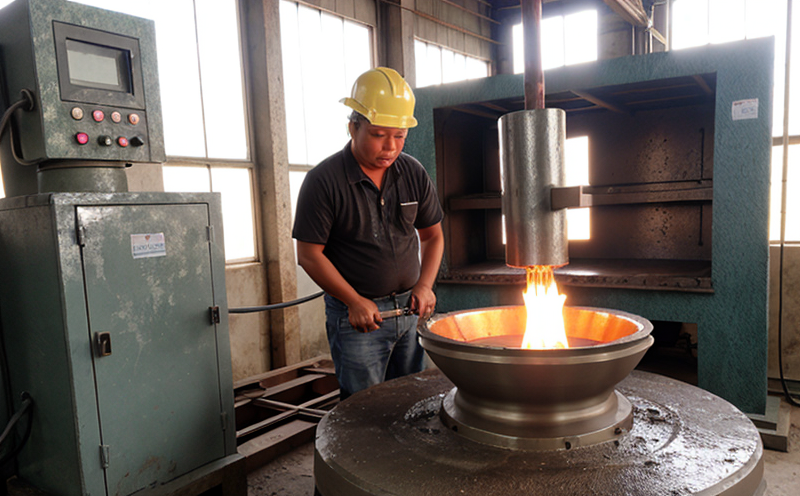ISO 8103 Ultrasonic Attenuation Testing of Cast Components
The ISO 8103 standard outlines a method for determining the ultrasonic attenuation in cast components. This testing technique is particularly useful in industrial manufacturing and processing, where quality assurance and compliance are critical. The casting process involves melting metal alloys, pouring them into molds, and allowing them to cool and solidify. Ensuring that these materials have consistent mechanical properties is essential for their safe and reliable use.
The casting process can introduce defects such as porosity, inclusions, and segregation that affect the material's integrity. Ultrasonic attenuation testing measures how sound waves travel through a material and are absorbed or scattered by internal flaws. This information helps manufacturers identify areas with poor quality and take corrective actions before components are finalized.
The ISO 8103 standard specifies the procedure for performing ultrasonic testing of castings using pulse-echo techniques. It is applicable to various materials, including ferrous and nonferrous metals, as well as alloys used in industrial manufacturing applications like automotive parts, aerospace structures, and machinery components.
For this test, a pulsed ultrasonic wave is directed into the casting material. As the wave propagates through the component, it interacts with internal defects or variations in microstructure. The interaction causes part of the energy to be absorbed (attenuated) by the material, while some is reflected back to the transducer. By measuring both the amount and location of this reflected signal, technicians can assess the quality of the casting.
One key aspect of ISO 8103 testing is the use of reference standards. These benchmarks allow operators to calibrate their equipment accurately and ensure consistent results across different tests. The standard provides guidelines for selecting appropriate reference materials based on material type and expected defect levels.
The process typically involves several steps:
- Preparation of the casting sample following industry best practices.
- Cleaning and degreasing to remove contaminants that could interfere with ultrasonic wave propagation.
- Application of coupling agent between the transducer and the surface of the component.
- Positioning the transducer over suspected areas of interest or along a scan path if multiple regions need inspection.
- Data collection, including amplitude measurement of returned echoes.
The collected data is then analyzed to calculate attenuation coefficients which reflect the degree of sound wave energy loss per unit length. Higher values indicate more pronounced defects within the material structure.
Understanding the principles behind ultrasonic testing provides valuable insights into its practical applications in industrial settings. For instance, it allows quality managers to pinpoint problem areas early on during production cycles reducing costs associated with rework or scrap generation. Compliance officers benefit too by ensuring adherence to relevant international standards like ISO 8103 enhancing confidence among customers regarding product reliability.
When selecting a laboratory for performing ISO 8103 testing, look for facilities equipped with advanced ultrasonic testing machines capable of generating precise sound pulses and accurately measuring echo responses. Skilled personnel trained in interpreting test results are also crucial to obtaining reliable outcomes.
Applied Standards
The ISO 8103 standard is widely recognized for its comprehensive approach to ultrasonic attenuation testing of cast components. This section summarizes the key aspects covered by this international guideline:
- Audience: Quality managers, compliance officers, R&D engineers, and procurement professionals.
- Purpose: To provide a standardized method for measuring ultrasonic wave attenuation in cast parts.
- Scope: Covers the evaluation of various casting processes including iron-based alloys (ferrous) and non-iron-based ones (nonferrous).
- Methodology: Utilizes pulse-echo techniques to assess material properties through sound wave interaction with defects.
The standard ensures that tests are conducted consistently across different laboratories around the world, promoting interoperability among industries. By adhering strictly to ISO 8103 procedures, manufacturers can demonstrate compliance with global regulations while maintaining high standards of product quality.
Scope and Methodology
| Aspect | Description |
|---|---|
| Type of Materials Covered: | Ferrous metals like iron, steel; nonferrous metals such as aluminum, copper. |
| Purpose: | To determine the ultrasonic attenuation in cast components during manufacturing processes. |
| Methodology: | Pulse-echo technique where pulsed ultrasonic waves are sent into a casting material, and their interaction with defects is analyzed. |
In practice, the testing begins by preparing the casting sample according to specified dimensions in ISO 8103. Once prepared, the surface of the component must be cleaned thoroughly using appropriate solvents or detergents to eliminate any foreign substances that might distort ultrasonic wave propagation.
The next step involves applying coupling agent between the transducer and the casting's surface. Coupling agents such as water, oil, or grease facilitate efficient transmission of sound waves from the probe into the material without air gaps causing significant attenuation losses.
After ensuring proper setup, technicians position the transducer over specific areas suspected to contain defects or along predetermined scan paths covering larger portions of the casting. The transducer emits short bursts of ultrasonic energy, which travel through the material and encounter any internal imperfections present.
The resulting echoes are captured by the receiver portion of the instrument and processed into data representing attenuation levels across different depths within the component. These measurements form the basis for assessing overall cast quality.
Quality and Reliability Assurance
- Reference Standards: The use of calibrated reference materials ensures accurate test results.
- Data Analysis: Advanced software tools analyze collected data to determine attenuation coefficients accurately.
- Equipment Calibration: Regular calibration checks maintain the precision and accuracy of ultrasonic testing devices.
- Training Programs: Continuous training for staff ensures they stay updated on latest techniques and best practices.
By implementing these quality assurance measures, laboratories can guarantee reliable test results that meet or exceed industry expectations. Properly trained personnel combined with well-maintained equipment contribute significantly towards maintaining consistent standards throughout all phases of testing.





